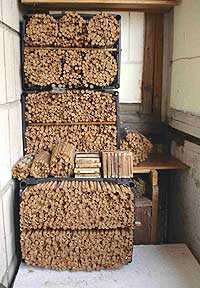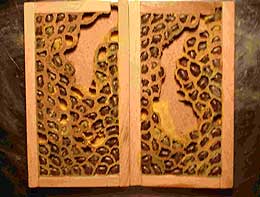|
< PREVIOUS
PAGE >
Rearing osmia
bees in Ukraine
Dr Komissar
Alexander
The
Beekeepers Quarterly Number 82 • Autumn 2005, pages 41-42
Solitary Osmia bees (O.rufa and O.cornuta) are native
in Ukraine and they are widespread species. These bees build their nests
in natural tubes and different cracks in stones, in wood, or between bricks.
As there are many favourable places for their nests where people live,
there is a good urban population of these bees.
These species abound during the springtime their
active period of life coinciding with the blossoming of garden fruit trees.
Because of this they are useful pollinators in gardens and have two advantages
in comparison with honeybees: they are able to work at a lower temperature
and the effectiveness of pollination, at one visit, is essentially better.
Osmia rufa is the more northern species and is found even in Northern Europe.
Osmia cornuta’s northerly limit of distribution almost coincides with the
northern border of Ukraine. From my own point of view the O. cornuta bees
are the most beautiful bees in the world, they are like small black and
red bumble bees. In some localities the density of population of osmia
bees is very (or even extremely) large.
As a rule, in such places the nest cavities are
in abundance. However, conversely. there are localities where these bees
are completely absent and this fact hasn’t a simple scientific explanation.
Similarly, there seems to be no reason why in some
areas there are very significant changes in the density of population of
these bees. Many examples are known of villagers having constant problems
with keyholes being sealed with clay by the osmia bees. Once my friend
had the problem of having to clean the rubber oil hose in his car as it
was choked up with osmia bee nests. In one village, where there were many
old sheds with the reed stem roofs, I observed the flight of many insects
like bees from a hole in the vertical clay wall. The intensity of their
flight was similar to that of a very strong honeybee colony. At first I
thought that it was a very rare and interesting case of a honeybee swarm
living in an underground nest. As this occured in May, before the start
of the swarming season, it would have been especially interesting. for
the swarm would have had to have been an overwintered colony and such cases
have not been described in apicultural literature as honey bees don’t live
in the ground, nor in clay, at all. But the bees from underground were
not honeybees - they were Osmia rufa bees, but these bees don’t live in
colonies. Careful observation of the bees showed that all the bees flying
out had the lumps of clay in their mandibles. The reason for this phenomenon
was very simple. That year the spring was extremely dry and osmia bees
had problems obtaining wet clay which they usually use for the building
of partitions between cells and for the sealing of the entrance to the
nest. Osmia bees from surrounding localities had discovered a common clay-mine
and were able to make use of the wet and soft clay which was underground.
This case is just one example of to show the abundance of osmia bees in
favorable localities.
My first meeting with osmia bees took place in childhood
near the reed stem roof of an old shed. These lovely bees worked busily
and sealed the ends of the tubes with clay or even mud. A second close
meeting was in my own small-scale queen breeding station. I had invented
extra-multiple mating hives and used these hives only in this apiary (see
the previous issue of BKQ, #81, pages 44-46). Common feeders are an important
feature of these hives and 10 mm splits were an essential component of
these feeders. The populating of the mating hives with honey bees usually
occurred after the fruit trees had finished flowering - ie, at the end
of the osmia season. Because of this I had problems with osmia nests in
my mating hives every year: the feeder gaps were choked up with osmia bee
cells. For several years I was forced to destroy the osmia bee cells in
my feeders. As an entomologist I was sad to do this as I hadn’t any other
option at that time. However, I have now found a solution by placing special
osmia bee traps in the slots or gaps in my mating hives. These were simply
designed devices with 6 -10 mm spaces between two parallel plates, one
of which could be glass. (Fig.2). These osmia “observation hives” were
used by osmia bees very well. The filled osmia traps (with clay partitions,
pollen and larvae) were removed from the apiary to my balcony in my town
apartment, were I have a small osmia apiary as a hobby (Fig.1).
 |
Fig.1. The
osmia bee hobby apiary on the balcony of a second floor apartment. The
observation osmia glass /plywood slots iare in the lower part of the photo.
The boxes with reed tubes are in the upper part. The beautiful red-black
Osmia cornuta bees prefer the reed tubes and the Osmia rufa bees’ nests
can be found in the tubes and in the different artificial slots. |
All these bees were Osmia rufa only. Later I added
some very beautiful Osmia cornuta bees from the southern localities. These
bees prefer to make their nests in the reed tubes only and used the “osmia
observation hives” only rarely.
The famous Ukrainian osmia bee scientist, Dr B Zinchenko,
created large scale osmia apiary in the Poltava region. He started osmia
bee rearing in 1973 from 110 cocoons and increased the population during
18 years to 5 million cocoons. The coefficient of multiplication changed
from 0.79 in bad years to 6.26 in favourable ones (the average for 18 years
was 1.8). The largest quantity of osmia bees was nearly 5 million at his
apiary. This is the same quantity of bees as you will find in May in an
apiary of 200 - 250 honeybee colonies. A technology for the large scale
rearing of osmia bees was developed and methods were devised to overcome
their various illnesses and parasites. Unfortunately, Dr Zinchenko had
none of his work published in English and his sudden death almost stopped
any further progress in this very interesting kind of beekeeping. His death
coincided with the collapse of the government’s financial support of science
in Ukraine and now we have the small osmia apiary instead of the large
one in the Poltava region (see fig. 3) and no scientific investigations
are taking place.
 |
Fig.2. Osmia
cocoons in the two “osmia bees observation slots or osmia bees “observation
hives”. It is possible to see dead larva which have been damaged by different
parasites. Several bees fill one observation hive, in each tube every bee
has its own nest. It is also possible, with these, to see the results of
rearing after the end of osmia activity and even to observe the larvae’s
growth. |
 |
Fig. 3. Blocks
of 15 boxes with reed tubes for osmia bee rearing in the Poltava region.
More than 20,000 reed tubes are in the field of view. 3 such blocks was
populated by osmia bees in 2005 , two species of osmia bees (O.rufa and
O.cornuta) live in tubes together and the cocoons which are marketed are
usually a mixture of the both species |
The osmia bees reared in this apiary are sold
- the usual customers being the owners of small glasshouses or polytunnels
who grow cucumbers and where the use of honeybee colonies for pollination
is relatively expensive. Honeybee colonies in greenhouses need special
management whilst the use of osmia bees is extremely simple and doesn’t
demand any special knowledge. During the five years between 1986 and 1990,
more than 3 million cocoons were sold to more than 500 customers. Now less
than one hundred thousands of cocoons appear on the market every year.
However, during the last several years, including this 2005 season, conditions
were unfavorable for osmia rearing and the coefficient of the years’ cocoon
multiplication was low - just slightly more than 1. The use of these bees
for pollination is restricted now to greenhouses where cucumbers are cultivated.
However, Ukraine has an enormous potential for the
rearing of osmia bees and the experiments of the late Dr B Zinchenko support
this conclusion. Several Ukrainian honey beekeepers, though, have the bands
of reed tubes for osmia bees as decorations in their honeybee apiary. This
is becoming a modern fashion ever since the publication of one beekeeper’s
work about the nice black-red bees like bumblebees. It is possible to see
such bees even in the private apiary of President of Ukraine Victor Yuschenko!
It is possible
to see more information about the rearing of Osmia bees in the UK, in Matthew
Allen’s “Working with the Oxford Bee Company” Bee Biz, 2003, #16:23-27.
Christopher O. Toole’s “The Red Mason Bees”, (2000, 35 pp) an important
handbook on the subject, is also available from Northern Bee Books. Editor.
< PREVIOUS
PAGE >
To the top
Design
Yuri
Mirny
|

